Developments and Industrial Applications of Basalt Fibre Reinforced Composite Materials
Abstract
1. Introduction
2. Basalt
2.1. Manufacturing Techniques for Basalt Fibre Production
2.2. Mechanical Properties of Basalt Fibres
| Fibre | Fibre Diameter (µm) | Density (g/cm3) | Tensile Strength (MPa) | Modulus of Elasticity (GPa) | Elongation at Break (%) | Price (USD/kg) |
|---|---|---|---|---|---|---|
| Basalt | 9–23 | 2.8–3.0 | 3000–4840 | 79.3–93.1 | 3.1 | 2.5–3.5 |
| E-glass | 9–13 | 2.5–2.6 | 3100–3800 | 72.5–75.5 | 4.7 | 0.75–1.2 |
| S-glass | 9–13 | 2.46–2.5 | 4590–4830 | 88–91 | 5.6 | 5–7 |
| Carbon | 4–7.5 | 1.75–1.9 | 3500–6000 | 230–600 | 1.5–2.0 | 30 |
| Aramid | 5–18 | 1.44 | 2900–3400 | 70–112 | 2.8–3.6 | 25 |
2.3. Chemical Properties of Basalt Fibres
| Oxides Content (wt. %) | Basalt | E-Glass |
|---|---|---|
| SiO2 | 47.5–53.0 | 53.4 |
| Al2O3 | 13.3–18.0 | 14.3 |
| Fe2O3 | 7.0–14.0 | 0.28 |
| CaO | 8.0–11.0 | 19.0 |
| MgO | 3.5–5.0 | 3.3 |
| B2O3 | 0.8 | 10.3 |
| TiO2 | 0.2–3.5 | 0.14 |
| Na2O + K2O | 2.5–6.0 | 0.29 |
| ZrO2 | 0.0 | 0.8 |
| MnO | 0.17–0.22 | N/A |
2.4. Thermal Properties of Basalt Fibres
3. Mechanical Properties of Basalt Fibre Reinforced Composites
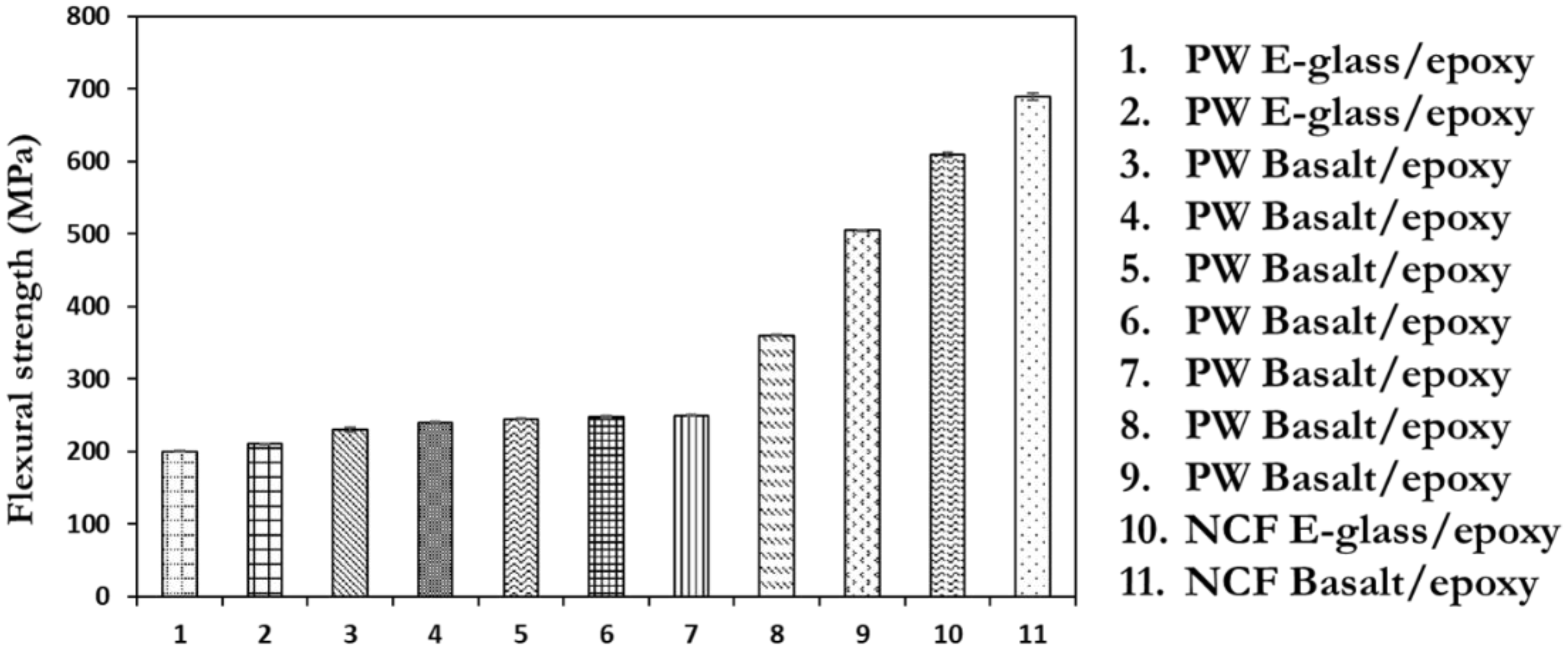
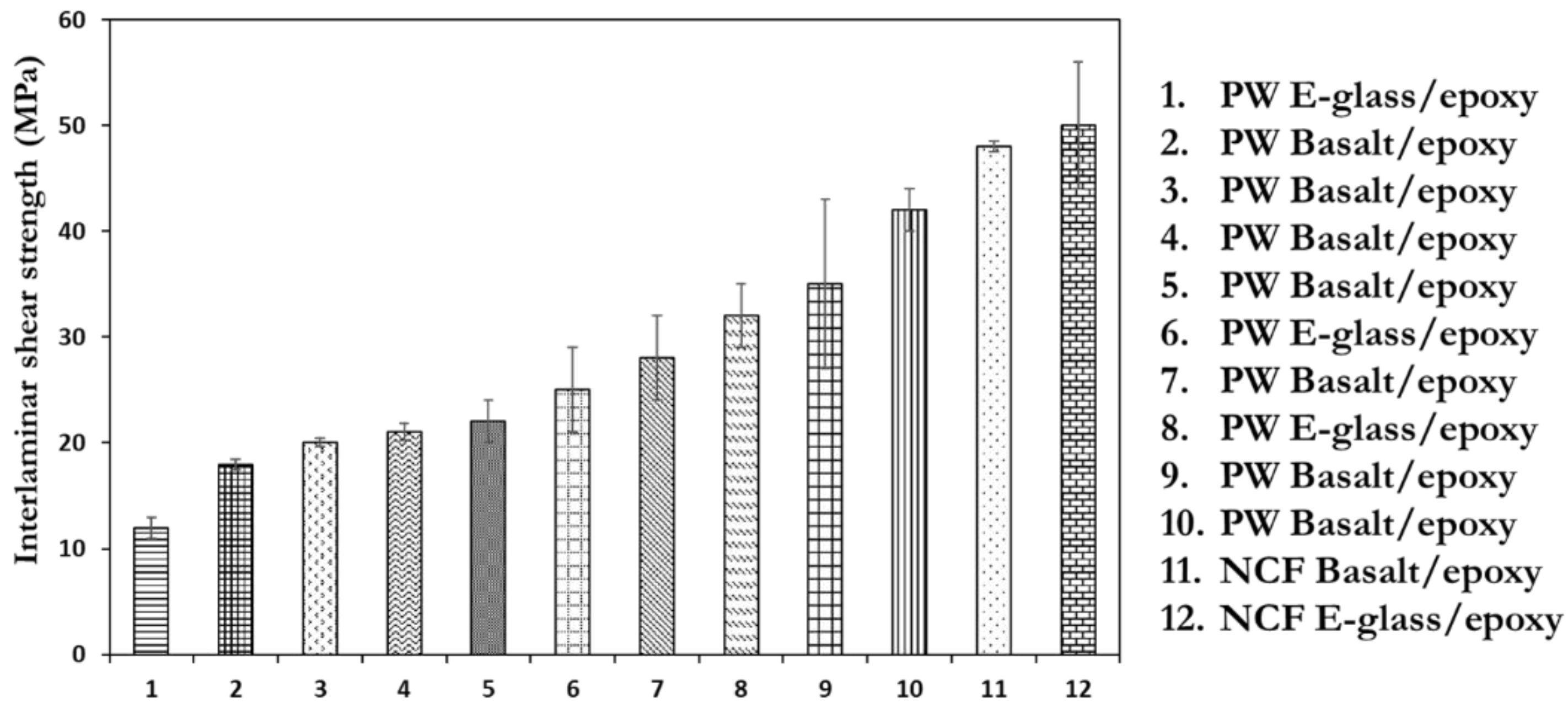
Failure Mechanisms in Basalt Fibre Reinforced Composites
4. Durability of Basalt Fibre Reinforced Composites
4.1. Durability in Moist Conditions
4.2. Thermal Stability
4.3. Chemical Durability
5. Life Cycle Assessments (LCA)
6. Industrial Applications
6.1. Automobile Industry
6.2. Construction Industry
6.3. Road Engineering
6.4. Energy Industry
6.5. Sports Equipments
6.6. Other Applications
7. Conclusions
Author Contributions
Funding
Institutional Review Board Statement
Informed Consent Statement
Data Availability Statement
Conflicts of Interest
References
- Park, S.J.; Seo, M.K. Composite Characterization. Interface Sci. Technol. 2011, 18, 631–738. [Google Scholar]
- Vallittu, P.K. Fibre-Reinforced Composites for Dental Applications. In Dental Biomaterials; Curtis, V., Watson, T.F., Eds.; Woodhead Publishing: Southen, UK, 2008; pp. 239–260. [Google Scholar]
- Deb, A. Crashworthiness Design Issues for Lightweight Vehicles. In Materials, Design and Manufacturing for Lightweight Vehicles; Mallick, P.K., Ed.; Woodhead Publishing: Cambridge, UK, 2021; pp. 433–470. [Google Scholar]
- Randbaran, E.; Dayang, L.; Zahari, R.; Sultan, M.T.H.; Mazlan, N. Advantages and Disadvantages of Using Composite Laminates in the Industries. Mod. Approaches Mater. Sci. 2020, 32, 349–352. [Google Scholar]
- Rajak, D.K.; Pagar, D.D.; Menezes, P.L.; Linul, E. Fiber-Reinforced Polymer Composites: Manufacturing, Properties, and Applications. Polymers 2019, 11, 1667. [Google Scholar] [CrossRef] [PubMed]
- Gopalraj, S.K.; Karki, T. A review on the recycling of waste carbon fibre/glass fibre-reinforced composite: Fibre recovery, properties and life-cycle analysis. SN Appl. Sci. 2020, 2, 433. [Google Scholar] [CrossRef]
- Monaldo, E.; Nerilli, F.; Vairo, G. Basalt-based fiber-reinforced materials and structural applications in civil engineering. Compos. Structrs. 2019, 214, 246–263. [Google Scholar] [CrossRef]
- Dhand, V.; Mittal, G.; Rhee, K.Y.; Park, S.J.; Hui, D. A short review on basalt fiber reinforced polymer composites. Compos. Part B 2015, 73, 166–180. [Google Scholar] [CrossRef]
- Fiore, V.; Scalici, T.; Bella, G.D.; Valenza, A. A review on basalt fibre and its composites. Compos. Part B 2015, 74, 74–94. [Google Scholar] [CrossRef]
- Ibrahim, M.; Ebead, U.; Al-Ansari, M. Life Cycle Assessment for Fiber-Reinforced Polymer (FRP) Composites Used in Concrete Beams: A State-of-the-Art Review. In Proceedings of the International Conference on Civil Infrastructure and Construction, Doha, Qatar, 2–5 February 2020. [Google Scholar]
- Pavlovic, A.; Donchev, T.; Petkova, D.; Staletovic, N. Sustainability of alternative reinforcement for concrete structures: Life cycle assessment of basalt FRP bars. Constr. Build. Mater. 2022, 334, 127424. [Google Scholar] [CrossRef]
- Chowdhury, I.R.; Nash, N.H.; Portela, A.; ODowd, N.P.; Comer, A.J. Analysis of failure modes for a non-crimp basalt fiber reinforced epoxy composite under flexural and interlaminar shear loading. Compos. Structrs. 2020, 245, 112317. [Google Scholar] [CrossRef]
- Wei, B.; Cao, H.; Song, S. Environmental resistance and mechanical performance of basalt and glass fibres. Mat. Sci. Eng. A-Struct. 2010, 527, 4708–4715. [Google Scholar] [CrossRef]
- Singha, K.A. Short review on basalt fibre. Int. J. Text Sci. 2012, 1, 19–28. [Google Scholar]
- Dhè, P. Filament Composed of Basalt. U.S. Patent 1438428, 12 December 1922. [Google Scholar]
- Austin, H.F.; Subramanian, R.V. Extrusion in the Presence of a Reducing Agent. U.S. Patent 4149866, 17 April 1979. [Google Scholar]
- Subramanian, R.V.; Shu, K.H.H. Silane Coupling Agents for Basalt Fibre Reinforced Polymer Composites. In Molecular Characterization of Composite Interfaces; Ishida, K., Kumar, G., Eds.; Springer: New York, NY, USA, 1985; pp. 205–236. [Google Scholar]
- Park, J.M.; Subramanian, R.V. Interfacial shear strength and durability improvement by monomeric and polymeric silanes in basalt fibre/epoxy single-filament composite specimens. J. Adhes. Sci. Technol. 1991, 5, 459–477. [Google Scholar] [CrossRef]
- Lee, J.J.; Nam, I.; Kim, H. Thermal stability and physical properties of epoxy composite reinforced with silane treated basalt fibre. Fibers Polym. 2017, 18, 140–147. [Google Scholar] [CrossRef]
- Jung, T.; Subramanian, R.V. Strengthening of basalt fibre by alumina addition. Scr. Metall. Mater. 1993, 28, 527–532. [Google Scholar] [CrossRef]
- Dzhigiris, D.D.; Volynskii, A.K.; Kozlovskii, P.P. Principles of Production Technology for and Properties of Basalt Fibres. In Basalt Fibre Composite Materials and Structures; Teploenergetik: Moscow, Russia, 1980; pp. 54–81. [Google Scholar]
- Dzhigiris, D.D.; Makhova, M.F.; Gorobinskaya, V.D. Continuous Basalt Fibre. In Glass Ceram; Teploenergetik: Moscow, Russia, 1983; Volume 40, pp. 467–470. [Google Scholar]
- Wojnarovits, I. Mechanical change of basalt and glass wool fibres during aqueous corrosion at different temperatures. TIZ-Fachber. 1987, 111, 554–558. [Google Scholar]
- Aslanova, L.G. Method and Apparatus for Producing Basaltic Fibres. U.S. Patent 20020069678, 13 June 2002. [Google Scholar]
- Brik, V.B. Multifunctional Apparatus for Manufacturing Mineral Basalt Fibres. U.S. Patent 6647747, 18 November 2003. [Google Scholar]
- Brik, V.B. Apparatus Integrated with Ceramic Bushing for Manufacturing Mineral/Basalt Fibres. U.S. Patent 20060218972, 19 August 2014. [Google Scholar]
- IMARC Group. Basalt Fiber Market: Global Industry Trends, Share, Size, Growth, Opportunity and Forecast 2022–2027; IMARC Group: Sheridan, WY, USA, 2022. [Google Scholar]
- Militky, J.; Kovacic, V.; Rubnerova, J. Influence of thermal treatment on tensile failure of basalt fibers. Eng. Fract. Mech. 2002, 69, 1025–1033. [Google Scholar] [CrossRef]
- Militky, J.; Kovacic, V. Ultimate Mechanical Properties of Basalt Filaments. Text. Res. J. 1996, 664, 225–229. [Google Scholar] [CrossRef]
- Jamshaid, H.; Mishra, R. A green material from rock: Basalt fibre—A review. J. Text I 2016, 107, 923–937. [Google Scholar] [CrossRef]
- Czigány, T.; Vad, J.; Pölöskei, K. Basalt fibre as a reinforcement of polymer composites. Period Polytech. Mech. Eng. 2005, 49, 3–14. [Google Scholar]
- Greco, A.; Maffezzoli, A.; Casciaro, G.; Caretto, F. Mechanical properties of basalt fibres and their adhesion to polypropylene matrices. Compos. Part B Eng. 2014, 67, 233–238. [Google Scholar] [CrossRef]
- Deák, T.; Czigány, T. Chemical composition and mechanical properties of basalt and glass fibres: A comparison. Text. Res. J. 2009, 79, 645–651. [Google Scholar] [CrossRef]
- Gutnikov, S.I.; Malakho, A.P.; Lazoryak, B.I.; Loginov, V.S. Influence of alumina on the properties of continuous basalt fibres. Russ. J. Inorg. Chem. 2009, 54, 191–196. [Google Scholar] [CrossRef]
- Gurev, V.V.; Neproshin, E.I.; Mostovoi, G.E. The effect of basalt fibre production technology on mechanical properties of fibre. Glass Ceram. 2001, 58, 62–65. [Google Scholar] [CrossRef]
- Mishnaevsky jr, L.; Branner, K.; Petersen, H.N.; Beauson, J.; McGugan, M.; Sorensen, B.F. Materials for Wind Turbine Blades: An Overview. Materials 2017, 10, 1285. [Google Scholar] [CrossRef]
- Thomsen, O.T. Sandwich materials for wind turbine blades—Present and future. J. Sandw. Struct. Mater. 2009, 11, 7–26. [Google Scholar] [CrossRef]
- Summerscales, J.; Searle, T.J. Low-pressure (vacuum infusion) techniques for moulding large composite structures. Proc. Inst. Mech. Eng. Part L J. Mater. Des. Appl. 2005, 219, 45–58. [Google Scholar] [CrossRef]
- Grande, J.A. Wind Power Blades Energize Composites Manufacturing, Plastics Technology. 2008. Available online: https://www.ptonline.com/articles/wind-power-blades-energize-composites-manufacturing (accessed on 17 March 2019).
- Carbon fibre, vs. Carbon fibre vs. Fiberglass: A Comparison between the Two Materials Which Material Is Superior? Available online: https://infogr.am/carbon-fiber-vs-fiberglass (accessed on 11 August 2019).
- Haberkern, H. Tailor-made reinforcements. Reinf. Plast. 2006, 50, 28–33. [Google Scholar] [CrossRef]
- Ralph, C.; Lemoine, P.; Summerscales, J.; Archer, E.; Mcllhagger, A. Relationship among the chemical, mechanical and geometrical properties of basalt fibres. Text. Res. J. 2019, 89, 3056–3066. [Google Scholar] [CrossRef]
- Ramakrishnan, N.S.; Tolmare, V.; Brik, V.B. Performance Evaluation of 3-D Basalt Fibre Reinforced Concrete and Basalt Rod Reinforced Concrete. In NCHRP-IDEA Program Project Final Report; Transportation Research Board: Washington, DC, USA, 1998. [Google Scholar]
- Colombo, C.; Vergani, L.; Burman, M. Static and fatigue characterization of new basalt fibre reinforced composites. Compos. Struct. 2012, 94, 1165–1174. [Google Scholar] [CrossRef]
- Liu, H.; Yu, Y.; Liu, Y.; Zhang, M.; Li, L.; Ma, L.; Sun, Y.; Wang, W. A review on basalt fiber composites and their applications in clean energy sector and power grids. Polymers 2022, 14, 2376. [Google Scholar] [CrossRef]
- Brik, B. Basalt Fibre Composite Reinforcement for Concrete. In NCHR-IDEA Program Project Final Report; Transportation Research Board: Washington, DC, USA, 1997. [Google Scholar]
- Loos, M. Composites in Carbon Nanotube Reinforced Composites. In CNR Polymer Science and Technology; Willian Andrew Applied Science Publishers: New York, NY, USA, 2015; pp. 37–72. [Google Scholar]
- Mahltig, B.; Kyosev, Y. Basalt Fibres. In Inorganic and Composite Fibres; Production, Properties and Applications; Woodhead Publishing: Cambridge, UK, 2018; pp. 195–217. [Google Scholar]
- Martynova, E.; Cebulla, H. Glass Fibres. In Inorganic and Composite Fibres; Production, Properties and Applications; Woodhead Publishing: Cambridge, UK, 2018; pp. 131–163. [Google Scholar]
- Tempelman, E.; Shercliff, H.; van Eyben, B.N. Resin Transfer Moulding. In Manufacturing and Design: Understanding the Principles of How Things Are Made; Elsevier Ltd.: Amsterdam, The Netherlands, 2014; pp. 171–186. [Google Scholar]
- Wypych, G. Fillers—Origin, Chemical Composition, Properties, and Morphology in Handbook of Fillers; Chem Tec Publishing: Scarborough, ON, Canada, 2016; pp. 14–266. [Google Scholar]
- Wei, B.; Cao, H.; Song, S. Tensile behaviour contrast of basalt and glass fibres after chemical treatment. Mater. Des. 2010, 31, 4244–4250. [Google Scholar] [CrossRef]
- Nasir, V.; Karimipour, H.; Taheri-Behrooz, F.; Shokrieh, M.M. Corrosion behaviour and crack formation mechanism of basalt fibre in sulphuric acid. Corros. Sci. 2012, 64, 1–7. [Google Scholar] [CrossRef]
- Mengal, A.N.; Karuppanan, S.; Wahab, A.A. Basalt carbon hybrid composite for wind turbine rotor blades: A short review. Adv. Mater. Res. 2014, 970, 67–73. [Google Scholar] [CrossRef]
- Abashidze, S.; Marquis, F.D.; Abashidze, G.S. Hybrid fibre and nano powder reinforced composite for wind turbine blades. J. Mater. Res. Technol. 2015, 4, 60–67. [Google Scholar]
- Soukhanov, A.V.; Dalinkevich, A.A.; Gumargalieva, K.Z.; Marakhovsky, S.S. Modern Basalt Fibres, and Epoxy Basalt to Plastics: Properties and Applications. In Key Engineering Materials. Volume II: Interdisciplinary Concepts and Research; CRC Press: Boca Raton, FL, USA; Taylor & Francis Group: Oxford, UK, 2014; pp. 69–94. [Google Scholar]
- Wang, S.; Zhong, J.; Gu, Y.; Li, G.; Cui, J. Mechanical properties, flame retardancy, and thermal stability of basalt fibre reinforced polypropylene composites. Polymer Composites 2020, 41, 4181–4191. [Google Scholar] [CrossRef]
- Ralph, C.; Lemoine, P.; Boyd, A.; Archer, E.; Mcllhagger, A. The effect of fibre sizing on the modification of basalt fibre surface in preparation for bonding to polypropylene. Appl. Surf. Sci. 2019, 475, 435–445. [Google Scholar] [CrossRef]
- Bhat, T.; Fortomaris, D.; Kandare, E.; Mouritz, A.P. Properties of thermally recycled basalt fibres and basalt fibre composites. J. Mater. Sci. 2018, 53, 1933–1944. [Google Scholar] [CrossRef]
- . Mingchao, W.; Zuoguang, Z.; Yubin, L.; Min, L.; Zhijie, S. Chemical durability and mechanical properties of alkali-proof basalt fiber and its reinforced epoxy composites. J. Reinf. Plast. Compos. 2008, 27, 393–407. [Google Scholar] [CrossRef]
- Lilli, M.; Sarasini, F.; Fausto, L.D.; González, C.; Fernández, A.; Lopes, C.S.; Tirillo, J. Chemical Regeneration of Thermally Conditioned Basalt Fibres. Appl. Sci. 2020, 10, 6674. [Google Scholar] [CrossRef]
- Sim, J.; Park, C.; Moon, D.Y. Characteristics of basalt fibre as a strengthening material for concrete structures. Compos. Part B Eng. 2005, 36, 504–512. [Google Scholar] [CrossRef]
- Rabinovich, F.N.; Zueva, V.N.; Makeeva, L.V. Stability of basalt fibres in a medium of hydrating cement. Glass Ceram. 2001, 58, 431–434. [Google Scholar] [CrossRef]
- Scheffler, C.; Förster, T.; Mäder, E.; Heinrich, G.; Hempel, S.; Mechtcherine, V. Aging of alkali-resistant glass and basalt fibres in alkaline solutions: Evaluation of the failure stress by Weibull distribution function. J. Non-Cryst. Solids 2009, 355, 2588–2595. [Google Scholar] [CrossRef]
- Hao, L.; Yu, W. Evaluation of thermal protective performance of basalt fibre nonwoven fabrics. J. Therm. Anal. Calorim. 2009, 100, 551–555. [Google Scholar] [CrossRef]
- Ying, S.; Zhou, X. Chemical and thermal resistance of basalt fibre in inclement environments. J. Wuhan Univ. Technol.-Mater. Sci. Ed. 2013, 28, 560–565. [Google Scholar] [CrossRef]
- Moiseev, E.A.; Gutnikov, S.I.; Malakho, A.P.; Lazoryak, B.I. Effect of iron oxides on the fabrication and properties of continuous glass fibres. Inorg. Mater. 2008, 44, 1026–1030. [Google Scholar] [CrossRef]
- Gutnikov, S.I.; Manylov, M.S.; Lipatov, Y.a.V.; Lazoryak, B.I.; Pokholok, K.V. Effect of the reduction treatment on the basalt continuous fibre crystallization properties. J. Non-Cryst. Solids 2013, 368, 45–50. [Google Scholar] [CrossRef]
- Lipatov, Y.a.V.; Arkhangelsky, I.V.; Dunaev, A.V.; Gutnikov, S.I.; Manylov, M.S.; Lazoryak, B.I. Crystallization of zirconia doped basalt fibres. Thermochim. Acta 2014, 575, 238–243. [Google Scholar] [CrossRef]
- Varley, R.J.; Tian, W.; Leong, K.H.; Leong, A.Y.; Fredo, F.; Quaresimin, M. The effect of surface treatments on the mechanical properties of basalt-reinforced epoxy composites. Polym. Compos. 2013, 34, 320–329. [Google Scholar] [CrossRef]
- Wei, B.; Cao, H.; Song, S. Surface modification and characterization of basalt fibres with hybrid sizing. Compos. Part A Appl. S 2011, 42, 22–29. [Google Scholar] [CrossRef]
- Chen, W.; Shen, H.B.; Auad, M.L.; Huang, C.Z.; Nutt, S. Basalt fibre epoxy laminates with functionalized multi-walled carbon nanotubes. Compos. Part A 2009, 40, 1082–1089. [Google Scholar] [CrossRef]
- Kim, M.T.; Rhee, K.Y.; Park, S.J.; Hui, D. Effects of silane-modified carbon nanotubes on flexural and fracture behaviours of carbon nanotube-modified epoxy/basalt composites. Compos. B Eng. 2012, 43, 2298–2302. [Google Scholar] [CrossRef]
- Kim, M.T.; Rhee, K.Y.; Lee, B.H.; Kim, C.J. Effect of carbon nanotube addition on the wear behaviour of basalt/epoxy woven composites. J. Nanosci. Nanotechnol. 2013, 13, 5631–5635. [Google Scholar] [CrossRef] [PubMed]
- Lee, J.H.; Rhee, K.Y.; Park, S.J. The tensile and thermal properties of modified CNT reinforced basalt/epoxy composites. Mat. Sci. Eng. A Struct. 2010, 527, 6838–6843. [Google Scholar] [CrossRef]
- Bashar, M.T.; Sundararaj, U.; Mertiny, P. Mode-I interlaminar fracture behaviour of nanoparticle modified epoxy/basalt fibre-reinforced laminates. Polym. Test. 2013, 32, 402–412. [Google Scholar] [CrossRef]
- Wei, B.; Song, S.; Cao, H. Strengthening of basalt fibres with nano-SiO2–epoxy composite coating. Mater. Des. 2011, 32, 4180–4186. [Google Scholar] [CrossRef]
- Wang, G.J.; Liu, Y.W.; Guo, Y.J.; Zhang, Z.X.; Xu, M.X.; Yang, Z.X. Surface modification and characterizations of basalt fibres with non-thermal plasma. Surf. Coat. Tech. 2007, 201, 6565–6568. [Google Scholar] [CrossRef]
- Kim, M.T.; Kim, M.H.; Rhee, K.Y.; Park, S.J. Study on an oxygen plasma treatment of a basalt fibre and its effect on the interlaminar fracture property of basalt/epoxy woven composites. Compos. Part B 2011, 42, 499–504. [Google Scholar] [CrossRef]
- Dorigato, A.; Pegoretti, A. Fatigue resistance of basalt fibres-reinforced laminates. J. Compos. Mater. 2012, 46, 1773–1785. [Google Scholar] [CrossRef]
- Wu, Z.; Wang, X.; Iwashita, K.; Sasaki, T.; Hamaguchi, Y. Tensile fatigue behaviour of FRP and hybrid FRP sheets. Compos. Part B Eng. 2010, 41, 396–402. [Google Scholar] [CrossRef]
- Lopresto, V.; Leone, C.; Iorio, I.D. Mechanical characterization of basalt fibre reinforced plastic. Compos. Part B 2011, 42, 717–723. [Google Scholar] [CrossRef]
- Palmieri, A.; Matthys, S.; Tierens, M. Basalt Fibres: Mechanical Properties and Applications for Concrete Structures. In Concrete Solutions, Proceedings of the International Conference on Concrete Solutions, International Conference on Concrete Solutions, Padua, Italy, 22–25 June 2009; Granham, M., Majorana, G., Eds.; CRC Press/Balkema: Leiden, The Netherlands, 2009; pp. 165–169. [Google Scholar]
- Chairman, C.A.; Kumaresh Babu, S.P. Mechanical and abrasive wear behaviour of glass and basalt fabric-reinforced epoxy composites. J. Appl. Polym. Sci. 2013, 130, 120–130. [Google Scholar] [CrossRef]
- Carmisciano, S.; Rosa, I.M.; Sarasini, F.; Tamburrano, A.; Valente, M. Basalt woven fiber reinforced vinylester composites: Flexural and electrical properties. Mater. Des. 2011, 32, 337–342. [Google Scholar] [CrossRef]
- Černý, M.; Glogar, P.; Sucharda, Z. Mechanical properties of basalt fibre reinforced composites prepared by partial pyrolysis of a polymer precursor. J. Compos. Mater. 2009, 43, 1109–1120. [Google Scholar] [CrossRef]
- Ary Subagia, I.D.G.; Tijing, L.D.; Kim, Y.; Kim, C.S.; Vista, F.P., IV; Shon, H.K. Mechanical performance of multiscale basalt fibre–epoxy laminates containing tourmaline micro/nanoparticles. Compos. Part B 2014, 58, 611–617. [Google Scholar] [CrossRef]
- Bulut, M. Mechanical characterization of Basalt/epoxy composite laminates containing graphene nano pellets. Compos. Part B 2017, 122, 71–78. [Google Scholar] [CrossRef]
- Petrucci, R.; Santulli, C.; Puglia, D.; Sarasini, F.; Torre, L.; Kenny, J.M. Mechanical characterization of hybrid composite laminates based on basalt fibres in combination with flax, hemp and glass fibres manufactured by vacuum infusion. Mater. Des. 2013, 49, 728–735. [Google Scholar] [CrossRef]
- Sun, G.; Tong, S.; Chen, D.; Gong, Z.; Li, Q. Mechanical properties of hybrid composites reinforced by carbon and basalt fibres. Int. J. Mech. Sci. 2018, 148, 636–651. [Google Scholar] [CrossRef]
- Sarasini, F.; Tirillo, J.; Ferrante, L.; Valente, M.; Valente, T.; Lampani, L.; Gaudenzi, P.; Cioffi, S.; Iannance, S.; Sorrentino, L. Drop-weight impact behaviour of woven hybrid basalt-carbon/epoxy composites. Compos. Part B 2014, 59, 204–220. [Google Scholar] [CrossRef]
- Scalici, T.; Pitarresi, G.; Badagliacco, D.; Fiore, V.; Valenza, A. Mechanical properties of basalt fibre reinforced composites manufactured with different vacuum-assisted impregnation techniques. Compos. Part B 2016, 104, 35–43. [Google Scholar] [CrossRef]
- Dorigato, A.; Pegoretti, A. Flexural and impact behaviour of carbon/basalt fibres hybrid laminates. J. Compos. Mater. 2014, 48, 1121–1130. [Google Scholar] [CrossRef]
- He, C.; Li, Y.; Zhang, Z.; Sun, Z. Impact damage modes and residual flexural properties of composites beam. J. Reinf. Plast. Compos. 2008, 27, 1163–1175. [Google Scholar]
- Sfarra, S.; Ibarra-Castanedo, C.; Santulli, C.; Paoletti, A.; Paoletti, D.; Sarasini, F. Falling weight impacted glass and basalt fibre woven composites inspected using non-destructive techniques. Compos. Part B 2013, 45, 601–608. [Google Scholar] [CrossRef]
- Shishevan, F.A.; Akbulut, H.; Mohtabdi-Bonab, M.A. Low velocity impact behavior of basalt fibre reinforced polymer composites. J. Mater. Eng. Perform. 2017, 26, 2890–2900. [Google Scholar] [CrossRef]
- Fu, H.; Feng, X.; Liu, J.; Yang, Z.; He, C.; Li, S. An investigation on anti-impact and penetration performance of basalt fibre composites with different weave and lay-up modes. Def. Technol. 2020, 16, 787–801. [Google Scholar] [CrossRef]
- Sanchez-Galvez, V.; Sancho, R.; Galvez, F.; Cendon, D.; Re de Pedraza, V. High speed impact performance of basalt fibre reinforced vinylester composites at room and low temperatures. Int. J. Lightweight Mater. Manuf. 2020, 3, 416–425. [Google Scholar]
- Arunprasath, K.; Naresh, K.; Amuthakkannan, P.; Manikandan, V.; Kavitha, S. Study of low velocity impact failure responses of woven basalt fibre reinforced polymer composites using ultrasonic A, B and C scan techniques. Adv. Mater. Process. Technol. 2022, 1–24. [Google Scholar] [CrossRef]
- Dhakal, H.M.; Mener, E.L.; Feldner, M.; Jiang, C.; Zhang, Z. Falling weight impact damage characterization of flax and flax basalt vinyl ester hybrid composites. Polymers 2020, 12, 806. [Google Scholar] [CrossRef]
- Zuccarello, B.; Bongjorno, F.; Militello, C. Basalt fibre hybridization effects on high performance sisal-reinforced biocomposites. Polymers 2022, 14, 1457. [Google Scholar] [CrossRef]
- Saleem, A.; Medina, L.; Skrifvars, M. Mechanical performance of hybrid bast and basalt fibres reinforced polymer composites. J. Polym. Res. 2020, 27, 61. [Google Scholar] [CrossRef]
- De La Rosa García, P.; Escamilla, A.C.; Nieves Gonzalez García, M. Bending reinforcement of timber beams with composite carbon fibre and basalt fibre materials. Compos. Part B 2013, 55, 528–536. [Google Scholar] [CrossRef]
- Davies, P.; Verbouwe, W. Evaluation of basalt fibre composites for marine applications. Appl. Compos. Mater. 2018, 25, 299–308. [Google Scholar] [CrossRef]
- Chowdhury, I.R.; O’Dowd, N.P.; Comer, A.J. Experimental study of hygrothermal ageing effects on failure modes of non-crimp basalt fibre-reinforced epoxy composite. Compos. Struct. 2021, 275, 114415. [Google Scholar] [CrossRef]
- De Rosa, I.M.; Marra, F.; Pulci, G.; Santulli, C.; Sarasini, F.; Tirillo, J. Post-impact mechanical characterisation of glass and basalt woven fabric laminates. Appl. Compos. Mater. 2012, 19, 475–490. [Google Scholar] [CrossRef]
- Gideon, R.K.; Hu, H.; Wambua, P.; Gu, B. Characterizations of basalt unsaturated polyester laminates under static three-point bending and low-velocity impact loadings. Polym. Compos. 2014, 35, 2203–2213. [Google Scholar] [CrossRef]
- Akinci, A. Mechanical and morphological properties of basalt filled polymer matrix composites. J. Mater. Sci. Eng. 2009, 35, 29–32. [Google Scholar]
- Akinci, A.; Yilmaz, S.; Sen, U. Wear behaviour of basalt filled low density poly- ethylene composites. Appl. Compos. Mater. 2012, 19, 499–511. [Google Scholar] [CrossRef]
- Zhang, X.; Pei, X.; Wang, Q. Friction and wear properties of polyimide matrix composites reinforced with short basalt fibres. J. Appl. Polym. Sci. 2009, 111, 2980–2985. [Google Scholar] [CrossRef]
- Zhang, X.; Pei, X.; Wang, Q. Friction and wear properties of basalt fibre rein- forced/solid lubricants filled polyimide composites under different sliding conditions. J. Appl. Polym. Sci. 2009, 114, 1746–1752. [Google Scholar] [CrossRef]
- Dak, T.; Cziany, T.; Tamas, P.; Nemeth, C. Enhancement of interfacial properties of basalt fibre reinforced nylon 6 matrix composites with silane coupling agents. Express Polym. Lett. 2010, 4, 590–598. [Google Scholar] [CrossRef]
- Meszaros, L.; Deak, T.; Balogh, G.; Czvikovszky, T.; Czigany, T. Preparation and mechanical properties of injection moulded polyamide 6 matrix hybrid nanocomposite. Compos. Sci. Technol. 2013, 75, 22–27. [Google Scholar] [CrossRef]
- Daniel, I.M.; Ishai, O. Engineering Mechanics of Composite Materials, 2nd ed.; Oxford University Press: New York, NY, USA, 2006. [Google Scholar]
- Herakovich, C.T. Mechanics of Fibrous Composites; Wiley: Hoboken, NJ, USA, 1997. [Google Scholar]
- Llorca, J.; Gonzalez, C.; Molina-Aldareguia, J.M.; Sergurado, J.; Seltzer, R.; Sket, F.; Rodriguez, M.; Sadaba, S.; Munoz, R.; Canal, P.L. Multiscale modelling of composite materials: A roadmap towards virtual testing. Adv. Mater. 2011, 23, 5130–5147. [Google Scholar] [CrossRef] [PubMed]
- Mortell, D.; Taneer, D.A.; Mccarthy, C.T. An experimental investigation into multi-scale damage progression in laminated composites in bending. Compos. Struct. 2016, 149, 33–40. [Google Scholar] [CrossRef]
- Smith, P.A.; Bonafice, L.; Glass, N.F.C. A comparison of transverse cracking phenomena in (0/90)s CFRP laminates. Appl. Compos. Mater. 1998, 53, 11–23. [Google Scholar] [CrossRef]
- Swofs, Y.; McMeeking, R.M.; Verpoest, I.; Gorbatikh, L. Matrix cracks around fiber breaks and their effect on stress redistribution and failure development in UD composites. Compos. Sci. Technol. 2015, 11, 16–22. [Google Scholar] [CrossRef]
- Arteiro, A.; Catalanotti, G.; Melro, A.; Linde, P.; Camanho, P. Micro-mechanical analysis of the in-situ effect in polymer composite laminates. Compos Struct. 2014, 150, 827–840. [Google Scholar] [CrossRef]
- Greenhalgh, E.; Hiley, M.; Meeks, C. Failure Analysis and Fractography of Polymer Composites, 1st ed.; Woodhead publishing Ltd.: Cambridge, UK, 2010. [Google Scholar]
- Martyniuk, K.; Sorensen, B.F.; Modregger, P.; Lauridsen, E.M. 3D in-situ observations for glass fibre/matrix interfacial debonding. Compos. Part A 2013, 12, 63–73. [Google Scholar] [CrossRef]
- Mahmood, A.S.; Summerscales, J.; James, M.N. Resin-rich volumes (RRV) and the performance of fibre-reinforced composites: A review. J. Compos. Sci. 2022, 6, 53. [Google Scholar] [CrossRef]
- Jespersen, K.M.; Glud, J.A.; Zangenberg, J.; Hosoi, A.; Kawada, H.; Mikkelsen, L.P. Uncovering the fatigue damage initiation and progression in UD non-crimp fabric reinforced polyester composite. Compos. Part A 2018, 109, 481–497. [Google Scholar] [CrossRef]
- Truong, T.C.; Vettori, M.; Lomov, S.; Verpoest, I. Carbon composites based on multi-axial multi-ply stitched preforms. Part 4. Mechanical properties of composites and damage observation. Compos. Part A 2005, 36, 1207–1221. [Google Scholar] [CrossRef]
- Sreekala, M.S.; Kumaran, M.G.; Thomas, S. Water sorption in oil palm fibre reinforced phenol formaldehyde composites. Compos. Part A Appl. Sci. Manuf. 2002, 33, 763–777. [Google Scholar] [CrossRef]
- Almudaihesh, F.; Holford, K.; Pullin, R.; Eaton, M. The influence of water absorption on UD and 2D woven CFRP composites and their mechanical properties. Compos. Part B 2020, 182, 107626. [Google Scholar] [CrossRef]
- Wright, W.W. The effect of diffusion of water into epoxy resins and their carbon fibre reinforced composites. Composites 1981, 12, 201–205. [Google Scholar] [CrossRef]
- Smith, L.; Schmitz, V. The effect of water on the glass transition temperature of poly (methyl methacrylate). Polymer 1988, 29, 1871–1878. [Google Scholar] [CrossRef]
- Passerini, N.; Craig, D.Q. An investigation into the effects of residual water on the glass transition temperature of polylactide microspheres using modulated temperature DSC. J. Control. Release 2001, 73, 111–115. [Google Scholar] [CrossRef]
- Grammatikos, S.A.; Zafari, B.; Evernden, M.C.; Mottram, J.T.; Mitchels, J.M. Moisture uptake characteristics of a pultruded fibre reinforced polymer flat sheet subjected to hot/wet aging. Polym. Degrad. Stab. 2015, 121, 407–419. [Google Scholar] [CrossRef]
- Bank, L.C.; Gentry, T.R.; Barkatt, A. Accelerated test methods to determine the long-term behaviour of frp composite structures: Environmental effects. J. Reinf. Plast. Compos. 1995, 14, 559–587. [Google Scholar] [CrossRef]
- Surathi, P.; Karbhari, V.M. Hygrothermal Effects on Durability and Moisture Kinetics of Fibre Reinforced Polymer Composites Report. Ph.D. Thesis, University of California, San Diego, CA, USA, 2006. [Google Scholar]
- Dhakal, H.N.; MacMullen, J.; Zhang, Z.Y. Moisture Measurement and Effects on Properties of Marine Composites. In Marine Applications of Advanced Fibre-Reinforced Composites, 1st ed.; Graham-Jones, J., Summerscales, J., Eds.; Woodhead Publishing: Cambridge, UK, 2016; pp. 103–124. [Google Scholar]
- Pandian, A.; Vairavan, M.; Thangaiah, W.J.J.; Uthayakumar, M. Effect of Moisture Absorption Behaviour on Mechanical Properties of Basalt Fibre Reinforced Polymer Matrix Composites. J. Compos. 2014, 4, 1–8. [Google Scholar] [CrossRef]
- Kim, Y.H.; Park, J.M.; Yoon, S.W.; Lee, J.W.; Jung, M.K.; Murakami, R.I. The Effect of Moisture Absorption and Gel-coating Process on the Mechanical Properties of the Basalt fibre Reinforced Composite. Int. J. Ocean. Syst. Eng. 2011, 3, 148–154. [Google Scholar]
- Ma, G.; Yan, L.; Shen, W.; Zhu, D.; Huang, L.; Kasal, B. Effects of water, alkali solution and temperature ageing on water absorption, morphology and mechanical properties of natural FRP composites: Plant-based jute vs. mineral-based basalt. Compos. Part B 2018, 153, 398–412. [Google Scholar] [CrossRef]
- Wang, Z.; Zhao, X.; Xian, G.; Wu, G.; Raman, R.K.S.; Al-Saadi, S. Durability study on interlaminar shear behaviour of basalt-. glass- and carbon-fibre reinforced polymer (B/G/CFRP) bars in seawater sea sand concrete environment. Constr. Build. Mater. 2017, 156, 985–1004. [Google Scholar] [CrossRef]
- Scida, D.; Assarar, M.; Poilane, C.; Ayad, R.; Khairuddin, N.; Marsin, A.M. Influence of hygrothermal ageing on the damage mechanisms of flax-fibre reinforced epoxy composite. Compos. Part B 2013, 48, 51–58. [Google Scholar] [CrossRef]
- Pritchard, G. Reinforced Plastics Durability; Woodhead Publishing Ltd.: Cambridge, UK, 1995. [Google Scholar]
- Liu, Q.; Shaw, M.T.; Parnas, R.S.; McDonnel, A.M. Investigation of basalt fibre composite aging behaviour for applications in transportation. Polym. Compos. 2006, 27, 475–483. [Google Scholar] [CrossRef]
- Wei, B.; Cao, H.; Song, S. Degradation of basalt fibre and glass fibre/epoxy resin composites in seawater. Corros. Sci. 2011, 53, 426–431. [Google Scholar] [CrossRef]
- Tang, C.; Xu, F.X.; Li, G. Combustion performance and thermal stability of basalt fiber-reinforced polypropylene composites. Polymers 2019, 11, 1826. [Google Scholar] [CrossRef]
- Landucci, G.; Rossi, F.; Nicolella, C.; Zanelli, S. Design and testing of innovative materials for passive fire protection. Fire Saf. J. 2009, 44, 1103–1109. [Google Scholar] [CrossRef]
- Shi, J.W.; Zhu, H.; Wu, Z.S.; Wu, G. Durability of BFRP and hybrid FRP sheets under freeze-thaw cycling. Adv. Mater. Res. 2011, 163, 3297–3300. [Google Scholar] [CrossRef]
- Shi, J.; Zhu, H.; Wu, Z.; Seracino, R.; Wu, G. Bond behavior between basalt fiber–reinforced polymer sheet and concrete substrate under the coupled effects of freeze-thaw cycling and sustained load. J. Compos. Constr. 2012, 17, 530–542. [Google Scholar] [CrossRef]
- Shokrieh, M.M.; Memar, M. Stress corrosion cracking of basalt/epoxy composites under bending loading. Appl. Compos. Mater. 2010, 17, 121–135. [Google Scholar] [CrossRef]
- Abouhamad, M.; Abu-Hamd, M. Life Cycle Assessment Framework for Embodied Environmental Impacts of Building Construction Systems. Sustainability 2021, 13, 461. [Google Scholar] [CrossRef]
- Fořt, J.; Kočí, J.; Černý, R. Environmental efficiency aspects of basalt fibres reinforcement in concrete mixtures. Energies 2021, 14, 7736. [Google Scholar] [CrossRef]
- Dong, S.; Xian, G.; Yi, X.-S. Life cycle assessment of ramie fibre used for FRPs. Aerospace 2018, 5, 81. [Google Scholar] [CrossRef]
- Oztürk, B.; Arslan, F.; Oztürk, S. Hot wear properties of ceramic and basalt fibre reinforced hybrid friction materials. Tribol. Int. 2007, 40, 37–48. [Google Scholar] [CrossRef]
- Wang, X.; Hu, B.; Feng, Y.; Liang, F.; Mo, J.; Xiong, J. 3D woven basalt/aramid hybrid composites. Compos. Sci. Technol. 2008, 68, 444–450. [Google Scholar] [CrossRef]
- Novitskii, A.G. High temperature heat insulating materials based on fibres from basalt type rock materials. Refract. Ind. Ceram. 2004, 45, 144–160. [Google Scholar] [CrossRef]
- Composites World. The Still-Promised Potential of Basalt Fibre Composites. 2020. Available online: https://www.compositesworld.com/articles/the-still-promised-potential-of-basalt-fiber-composites (accessed on 10 November 2022).
- Basaltfiber World. Basalt Fibre Applications. 2014. Available online: https://basaltfiberworld.wordpress.com/basalt-fiber-applications (accessed on 8 November 2022).
- Novitskii, A.G.; Sudakov, V.V. An unwoven basalt-fibre material for the encasing of fibrous insulation: An alternative to glass cloth. Refract. Ind. Ceram. 2004, 45, 239–241. [Google Scholar] [CrossRef]
- Pavlovski, D.; Mislavsky, B.; Antonov, A. CNG cylinder manufacturers test basalt Fiber. Reinf. Plast. 2007, 51, 36–37. [Google Scholar] [CrossRef]
- Basalt Fiber & Composite Materials Technology Development. Scope of Application of Basalt Fibre Materials. 2014. Available online: http://basaltm.com/en/bnv/scope-of-application-of-basalt-fiber-materials.html (accessed on 10 November 2022).
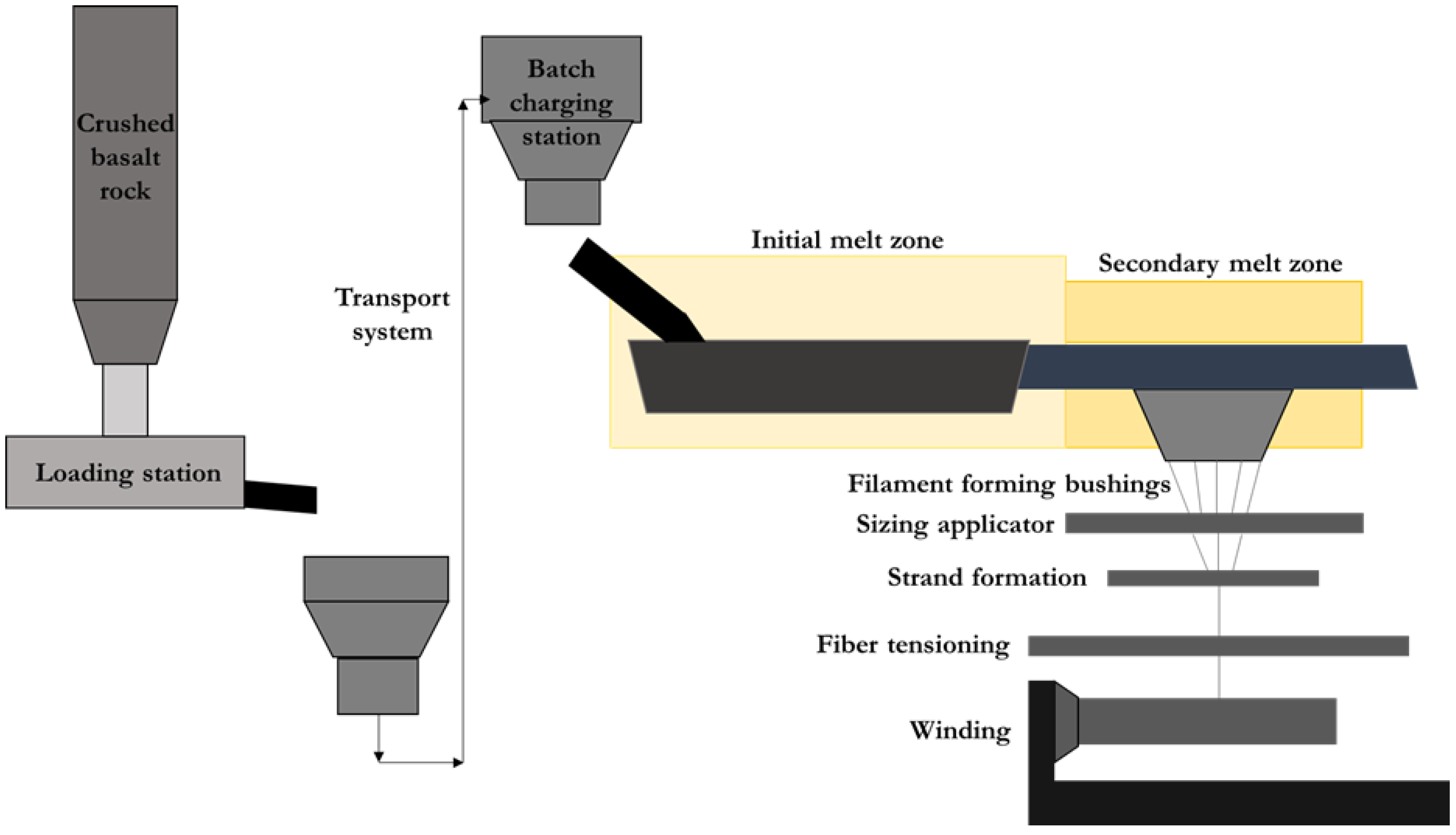
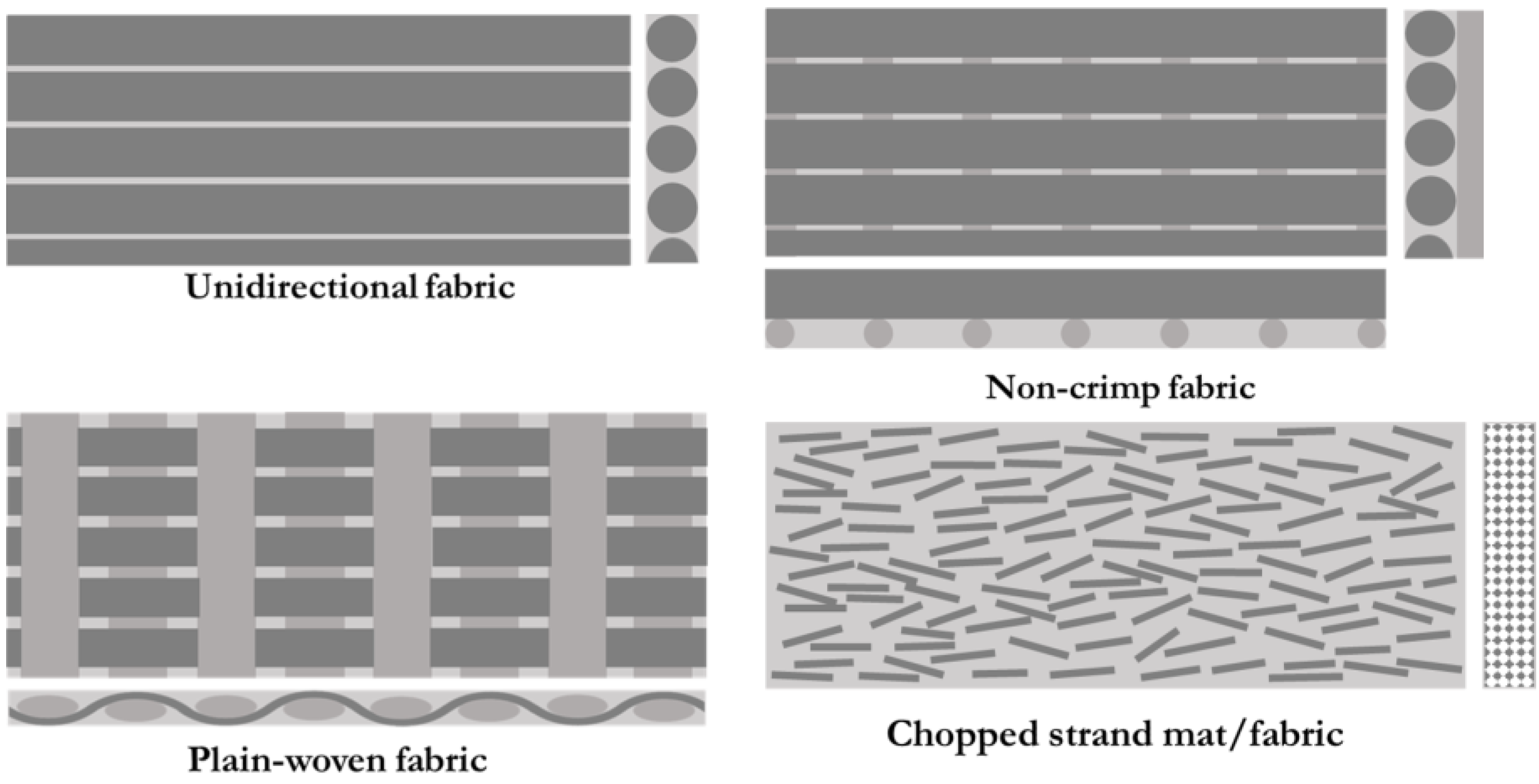
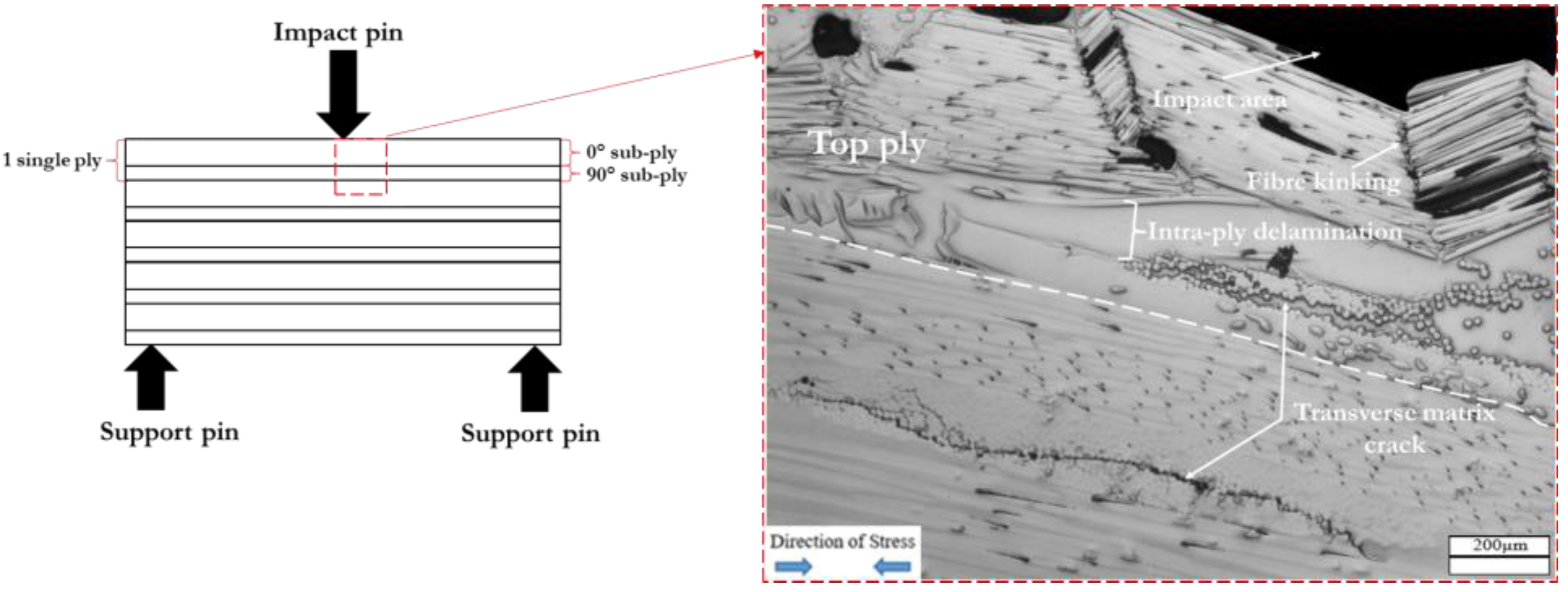

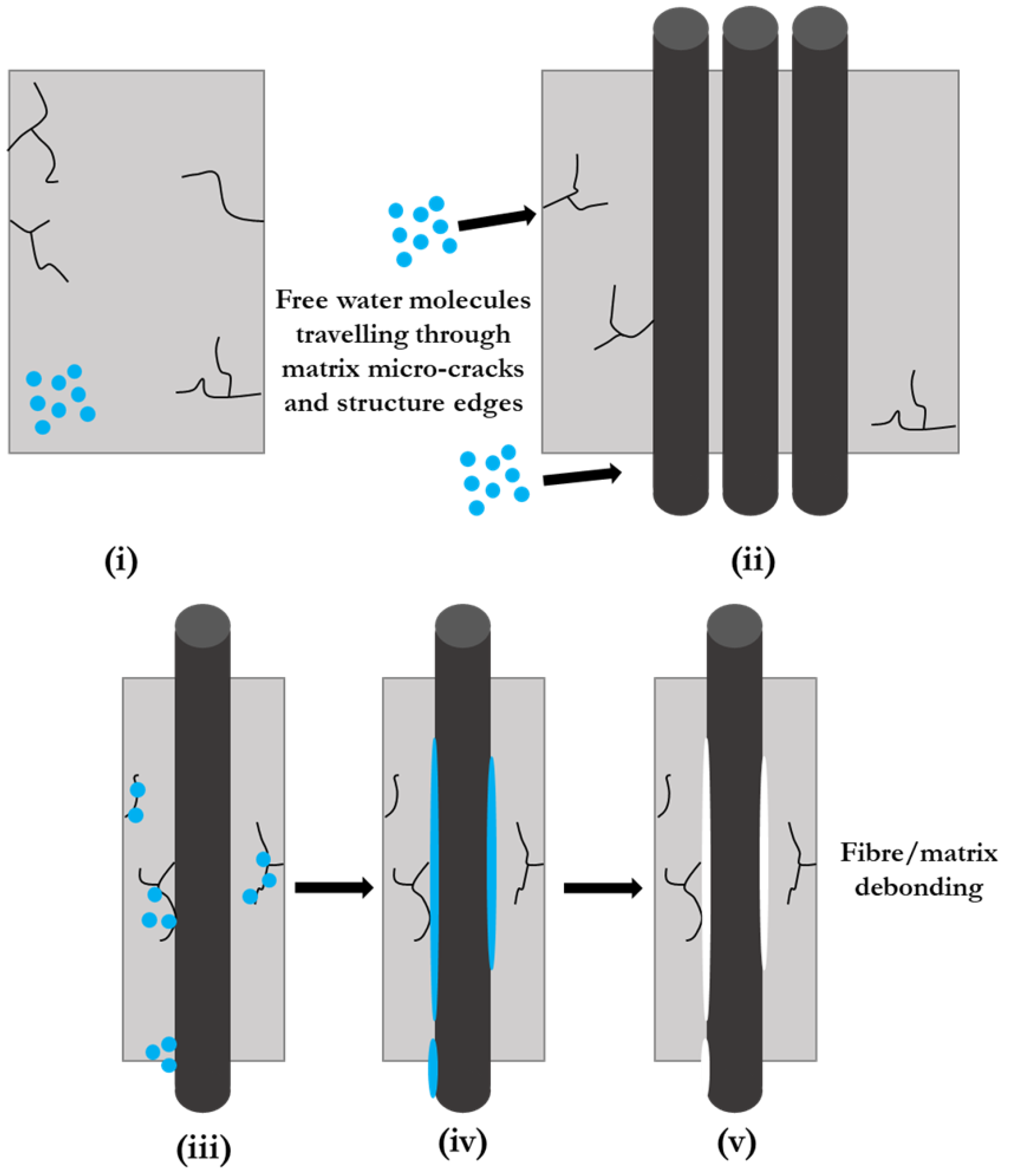
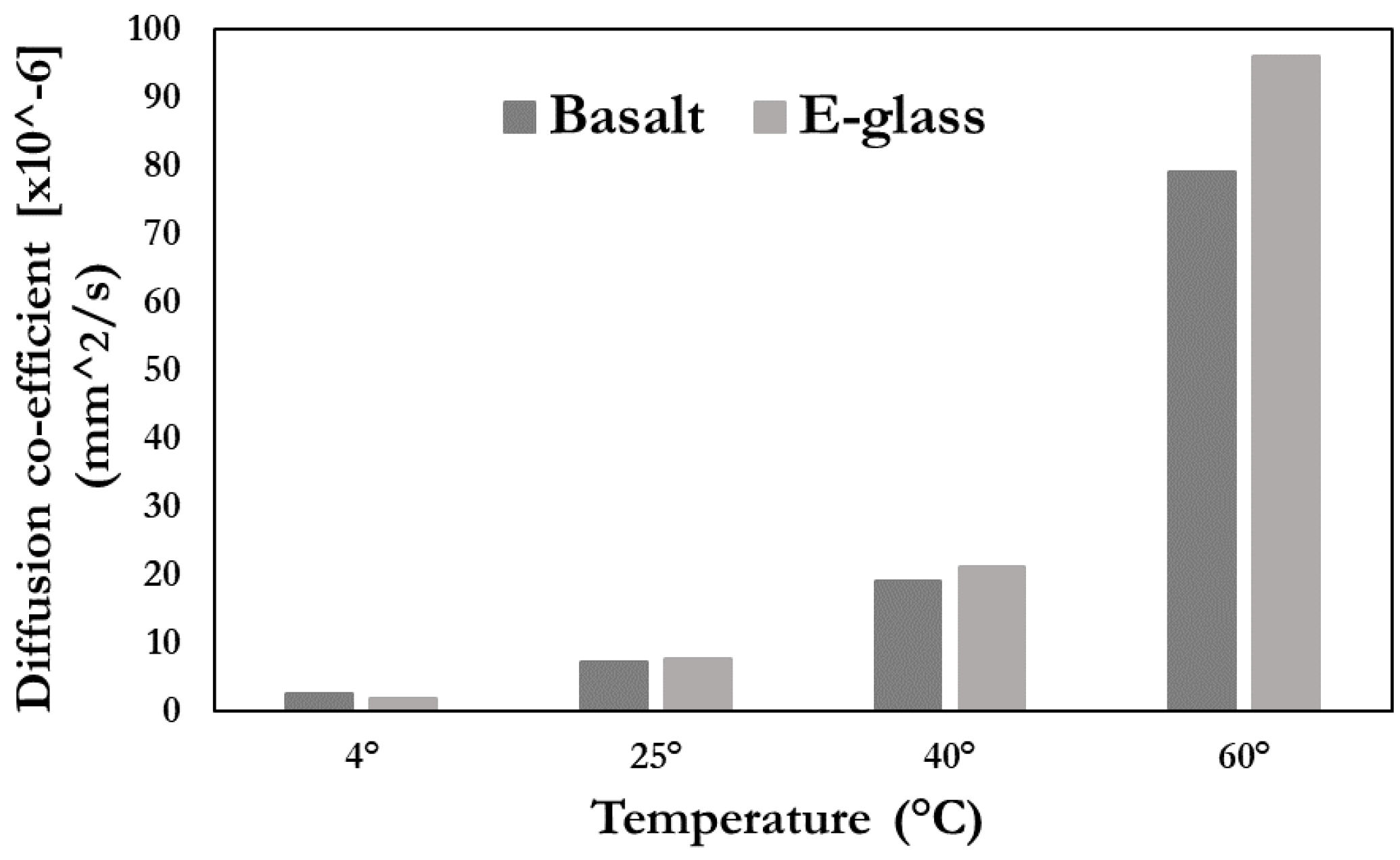

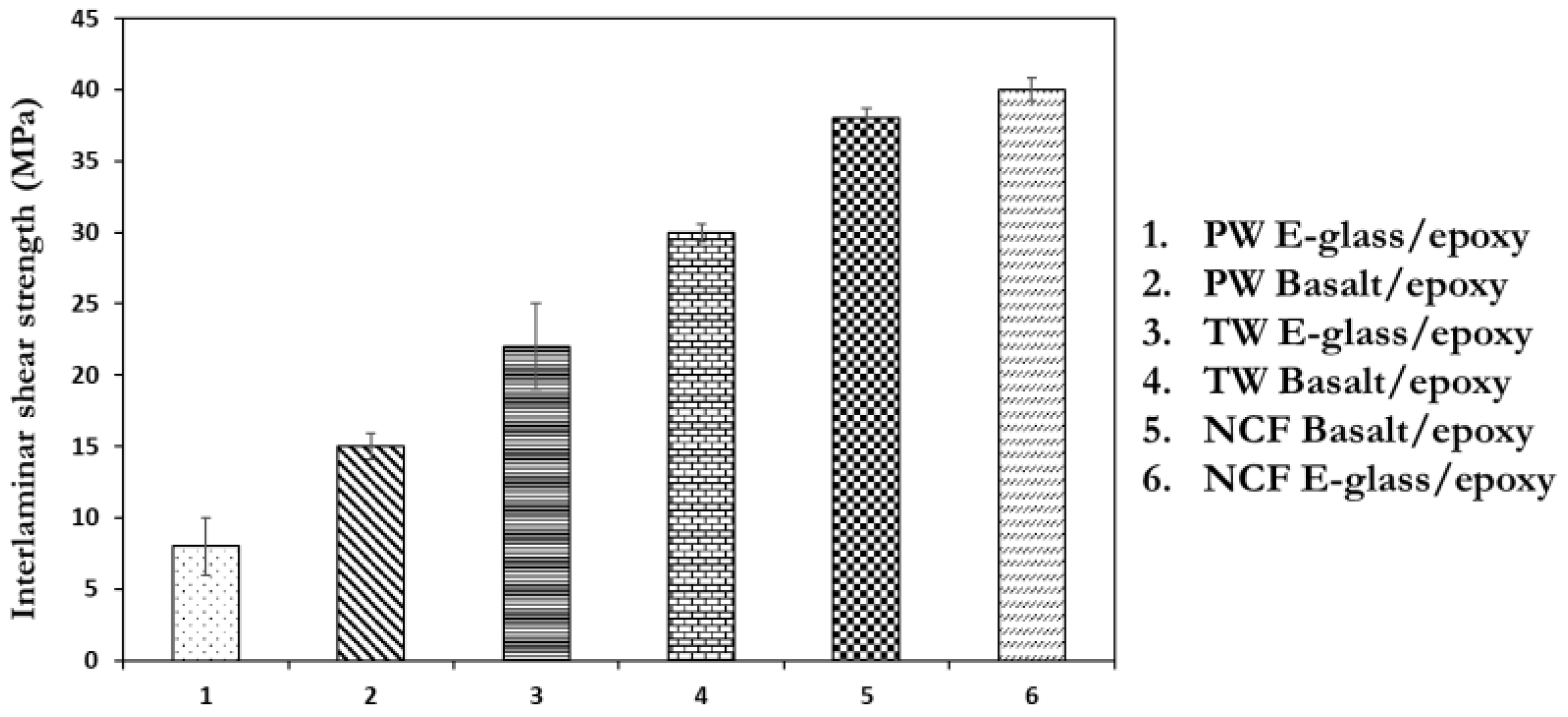
| Fibre | Working Temperature Range (∆T) [°C] | Thermal Conductivity (W·m−1·K−1) | Thermal Expansion Co-Efficient (10−6· °C−1) |
|---|---|---|---|
| Basalt | −260 to 700 | 0.031–0.038 | 8.00 |
| E-glass | −50 to 380 | 0.034–0.040 | 5.40 |
| S-glass | −50 to 300 | 0.034–0.040 | 29.00 |
| Carbon | −50 to 700 | 5–185 (axial only) | 0.05 (axial only) |
| Material | |||||
|---|---|---|---|---|---|
| Fibre type | Lay-up | ||||
| Basalt | 0° UD | 2.4 | 7 | 19 | 79 |
| E-glass | Quasi-UD | 1.8 | 7.5 | 21 | 96 |
| Material | NCF Basalt | NCF E-Glass | PW Basalt | PW Basalt | PW E-Glass | UD Basalt | UD Basalt | UD E-Glass |
|---|---|---|---|---|---|---|---|---|
| Epoxy | Araldite 1564 LY | Araldite 1564 LY | Polyester | Epoxy RIM 135/137 | Epoxy RIM 135/137 | Epoxy JN-C3P | Epoxy Bisphenol-A | Epoxy Bisphenol-A |
| Manufacturing process | VaRTM | VaRTM | Compression moulding | VaRTM | VaRTM | VaRTM | Pultrusion | Pultrusion |
| Immersion period | 200 days | 200 days | 24 h | ~100 days | ~100 days | 45 days | 84 days | 84 days |
| Temperature | 40 °C | 40 °C | Ambient | 80 °C | 80 °C | 40 °C | 40 °C | 40 °C |
| Media | seawater | seawater | seawater | distilled water | distilled water | distilled water | seawater | seawater |
| 1.5% | 1.25% | ~2% | ~3.5% | ~6% | ~0.8 % | ~3% | ~0.3% | |
| Literature | [104] | [104] | [135] | [136] | [136] | [137] | [138] | [138] |
| Category | Abbreviation | Unit | Basalt Fibre [149] | Glass Fibres [150] |
|---|---|---|---|---|
| Source | ||||
| Carcinogens | AC | kg C2H3Cl eq | 15.2 | - |
| Non-Carcinogens | NC | kg C2H3Cl eq | 12.1 | - |
| Respiratory Inorganics | RI | kg PM2.5 eq | 0.320 | - |
| Ionizing Radiation | IR | Bq C14 eq | 2.30 × 103 | - |
| Ozone Layer Depletion | OLD | kg CFC11 eq | 35.1 × 10−6 | 483 × 10−10 |
| Respiratory Organics | RO | kg C2H4 eq | 0.175 | - |
| Photochemical Oxidant | kg NMVOC | - | 5.26 | |
| Human Toxicity | kg 1,4-DB eq. | - | 20.8 | |
| Aquatic Ecotoxicity | kg TEG water | 256 × 103 | - | |
| Freshwater Aquatic Ecotoxicity | kg 1,4-DB eq. | - | 0.461 | |
| Terrestrial Ecotoxicity | kg TEG soil | 57.4 × 103 | - | |
| Terrestrial Acidification/Nutrification | TAN | kg SO2 eq | 6.56 | 10.3 |
| Land Occupation | LO | m2 organic arable | 8.05 | - |
| Aquatic Acidification | AA | kg SO2 eq | 1.34 | - |
| Aquatic Eutrophication | AEU | kg PO4 P-lim | 40.3 × 10−3 | 5.25 × 10−3 |
| Global Warming | GW | kg CO2 eq | 398 | 1740 |
| Non-Renewable Energy | NRE | MJ primary | 6630 | - |
| Fossil Depletion | kg oil eq. | - | 578 | |
| Mineral Extraction | ME | MJ surplus | 6.55 | - |
Publisher’s Note: MDPI stays neutral with regard to jurisdictional claims in published maps and institutional affiliations. |
© 2022 by the authors. Licensee MDPI, Basel, Switzerland. This article is an open access article distributed under the terms and conditions of the Creative Commons Attribution (CC BY) license (https://creativecommons.org/licenses/by/4.0/).
Share and Cite
Chowdhury, I.R.; Pemberton, R.; Summerscales, J. Developments and Industrial Applications of Basalt Fibre Reinforced Composite Materials. J. Compos. Sci. 2022, 6, 367. https://doi.org/10.3390/jcs6120367
Chowdhury IR, Pemberton R, Summerscales J. Developments and Industrial Applications of Basalt Fibre Reinforced Composite Materials. Journal of Composites Science. 2022; 6(12):367. https://doi.org/10.3390/jcs6120367
Chicago/Turabian StyleChowdhury, Indraneel R., Richard Pemberton, and John Summerscales. 2022. "Developments and Industrial Applications of Basalt Fibre Reinforced Composite Materials" Journal of Composites Science 6, no. 12: 367. https://doi.org/10.3390/jcs6120367
APA StyleChowdhury, I. R., Pemberton, R., & Summerscales, J. (2022). Developments and Industrial Applications of Basalt Fibre Reinforced Composite Materials. Journal of Composites Science, 6(12), 367. https://doi.org/10.3390/jcs6120367








